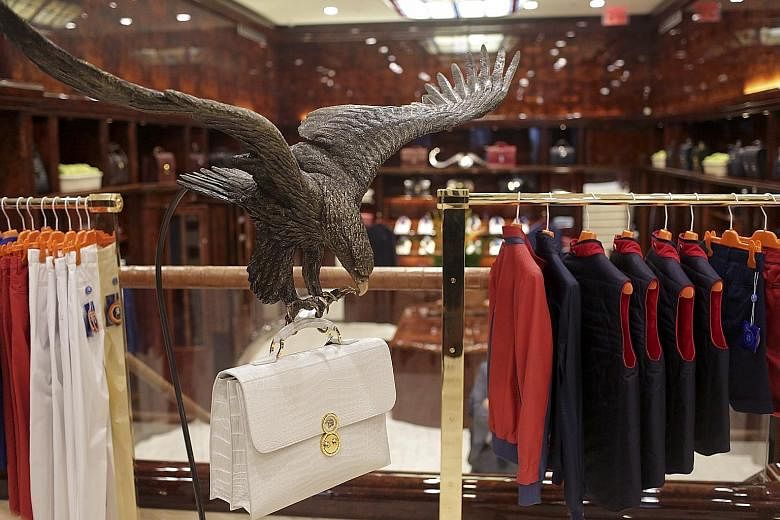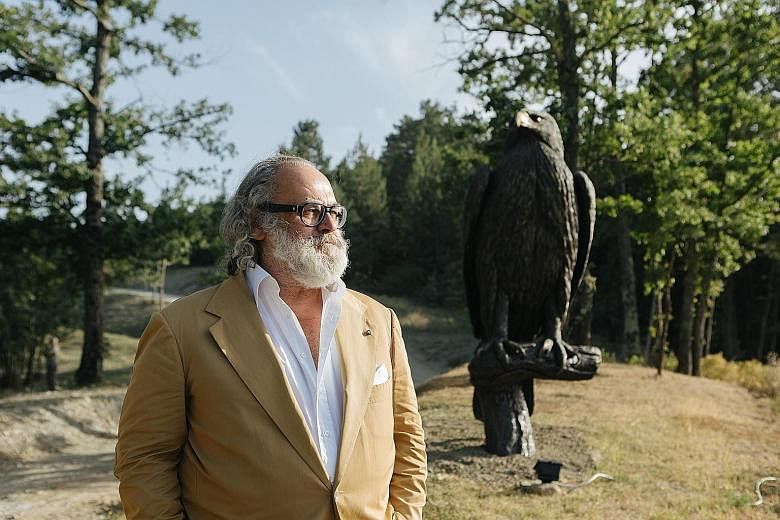NEW YORK • At the Stefano Ricci boutique on Park Avenue, Mr Filippo Ricci, the brand's creative director, was recounting a story about one of his clients, a wealthy industrialist.
"He had his first son's wedding one year, so he bought a pair of three-carat diamond cuff links that we made in our workshop," said Mr Ricci, 34, the younger son of the label's founder.
The cuff links, he added, cost US$100,000.
"A year later," he continued, "his other son got married. So we presented him with an US$80,000 tie, with 100 diamonds on it. We made six of them. One of them is owned by singer Elton John. When we went to deliver it, we said, 'Are you happy with the cuff links?'"
The father responded with a shrug. According to Mr Ricci, he said: "I lost them at the wedding. I partied too much."
Such mishaps are bound to arise when your client base is society's 0.001 per cent.
After nearly four decades, the Stefano Ricci label has come to occupy a unique place in the fashion firmament.
Makers of hyper-masculine, hyper-expensive menswear and accessories, this tightly held family business has outfitted Kremlin power brokers, Middle Eastern oil scions, celebrities such as classical singer Andrea Bocelli and actor Tom Cruise as well as world leaders such as the late South African president Nelson Mandela and the late German chancellor Helmut Kohl.
It is not so well known in the United States as its fellow Florence- based luxury brands Gucci and Salvatore Ferragamo, given its focus on emerging markets such as Russia, China and the Middle East.
But at a time when the balance of power is tipping eastwards and world leaders such as US President Donald Trump and Russian President Vladimir Putin have revived the concept of the unapologetic strongman, the time might be right for Stefano Ricci's sumptuous brand of oligarch chic.
Consider the eagle: a predator among predators that symbolises not just fierce individualism in the US, but strength in China, dynastic glory in the Middle East and ruling authority in Russia going back to the czars.
Which explains, in a roundabout way, why the eagle is an apt logo for Stefano Ricci.
"I'm emotionally tied to the concept of the eagle, with its elegance," Mr Stefano Ricci, 67, said in an interview. "The eagle stands for a sense of strength and control."
That matters when you are selling US$25,000 custom suits to heads of state or US$120,000 crocodile shirts for nightclubbing industrialists.
To the Stefano Ricci client, clothing serves a psychological function as much as a sartorial one - it must remind everyone, the wearers most of all, that they stand bestride the world like a colossus.
It is that swashbuckling sensibility, in fact, that Stefano Ricci relied on to build his business.
Since 1972, this Falstaffian Florentine - who hunts buffalo in Tanzania, keeps falcons on his Tuscan country estate and wears a set of ivory cuff links presented to him by a shaman in Africa - has charted his own course, one that seems to cry out for satellite navigation, given that, among its 54 stores worldwide, the company operates boutiques in Yerevan, Armenia; Baku, Azerbaijan; and Astana, Kazakhstan, in addition to those in the standard fashion capitals such as Milan and London.
That eastward expansion - a reversal of sorts of the Silk Road that once led from Asia to Italy - has been a company strategy since it opened its first outpost in China in 1993, when a Stefano Ricci tie cost about four months' salary of the average Chinese worker, the founder said.
"Everybody thought I was crazy," he said. "They were not wrong."
But he said the potential was obvious to him when he walked the streets of Beijing and Shanghai back then.
"I had the opportunity to see all these young people who were just walking faster than how I was used to seeing the people walking," he said. "When I looked into their eyes, I found an energy. I decided, these people are going to conquer the world."
As China's cities grew into forests of gleaming skyscrapers over the next quarter-century, the company opened another 11 boutiques there, including the 22,000 sq ft "mansion" in Shanghai that features an upstairs private club available to clients who spend more than US$100,000 a year, offering Cohiba cigars and white truffle ravioli, courtesy of Florentine chefs, among other amenities.
The elder Ricci also jumped in early on the Russian market, forging ties with its emergent industrialist class in the 1990s and opening a Moscow boutique in 2004. Seven years later, the company celebrated the opening of its second Moscow boutique, a short stroll from the Kremlin, with a lavish fashion show for 5,000 people.
The interior of the Kremlin, in fact, already featured sumptuous silk curtains and upholstery from the Antico Setificio Fiorentino, an 18th-century silk factory bought by Stefano Ricci in 2009. It still uses a warping machine designed by Leonardo da Vinci and has become a popular stop for vacationing plutocrats such as Amazon's chief executive officer Jeff Bezos.
Last year, the company presented a silk damask casula made of fabric from this artisanal workshop to Pope Francis on a visit to Florence.
The historic mill also supplies the company's Stefano Ricci Home division with exquisite fabrics such as ermisino, a shimmering silk taffeta woven from different colour threads that has been a favourite of the aristocracy since the Renaissance. Customers use it to decorate the interiors of their 20,000 sq ft pleasure domes as well as their 70m yachts.
Explaining the company's business in yacht interiors, Mr Filippo Ricci said: "What is the most luxurious thing you can buy for yourself? It's the megayacht. It's more than a plane, more than a car.
"You use it, what, two or three weeks a year? And it can be US$100 million. It's over-the-top luxury."
NYTIMES


